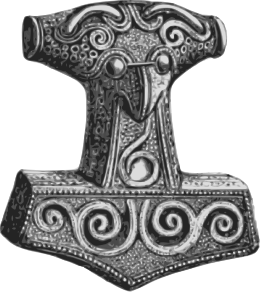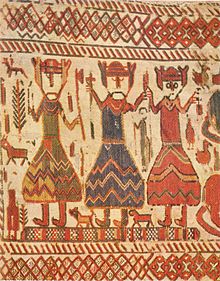Staronordijska religija


Staronordijska religija, znana tudi kot nordijsko poganstvo, je veja germanske religije, ki se je razvila v pranordijskem obdobju, ko so se severnogermanska ljudstva ločila v ločeno vejo germanskih ljudstev. V času pokristjanjevanja Skandinavije je bila vera pozabljena. Znanstveniki so kasneje uspeli rekonstruirati vidike severnogermanske religije s pomočjo zgodovinskega jezikoslovja, arheologije, toponimije in zapisov, ki so jih zapustila severnogermanska ljudstva, kot so runski napisi v mlajšem Futharku, izrazito severnogermanski razširitvi runske abecede. Številna staronordijska dela, ki segajo v 13. stoletje, beležijo nordijsko mitologijo, sestavni del severnogermanske religije.
Staronordijska religija je bila politeistična, vključevala je vero v različne bogove in boginje. Ta božanstva so bila v nordijski mitologiji razdeljena v dve skupini, Aze in Vane, ki naj bi se po nekaterih virih borili v starodavni vojni, dokler nista spoznali, da sta enako močni. Med najbolj razširjenimi božanstvi sta bila bogova Odin in Thor, mitološki svet pa je bil naseljen tudi z različnimi drugimi mitološkimi rasami, vključno z jötnar, škrati, vilinci in kopenskimi bitji. Nordijska kozmologija se je vrtela okoli svetovnega drevesa, znanega kot Yggdrasil, z različnimi kraljestvi, ki so obstajala poleg človeškega, imenovanega Midgard. Med njimi so tudi kraljestva posmrtnega življenja, od katerih jih več nadzoruje določeno božanstvo.
Prenesena prek ustnega izročila in ne prek kodificiranih besedil, se je staronordijska religija močno osredotočala na ritualno prakso, pri čemer so imeli kralji in poglavarji osrednjo vlogo pri izvajanju javnih žrtvovalnih dejanj. Uporabljeni so bili različni kultni prostori; sprva so bili tipično izbrani zunanji prostori, kot so nasadi in jezera, po tretjem stoletju našega štetja pa so bile ponekod za obredne dejavnosti namenoma zgrajene kultne hiše, čeprav njihova uporaba nikoli ni bila široko razširjena. V nordijski družbi so bili prisotni tudi izvajalci Seiðra, oblike čarovništva, ki jo nekateri znanstveniki opisujejo kot šamansko. Izvajali so različne oblike pokopa, vključno s polaganjem trupla v grob in upepeljevanjem, preminule pa so običajno spremljali različni grobni pridatki.
Skozi zgodovino so se med sosednjimi ljudstvi, kot so Samiji in Finci, pojavljale različne stopnje transkulturne difuzije. Do 12. stoletja je staronordijsko vero nadomestilo krščanstvo, elementi prejšnje vere pa so se ohranili v skandinavski folklori. Oživitev zanimanja za staronordijsko religijo se je zgodila sredi romantičnega gibanja 19. stoletja, v katerem je navdihnila vrsto umetniških del. Akademsko raziskovanje te teme se je začelo v zgodnjem 19. stoletju, sprva pod vplivom vsesplošnega romantičnega pogleda.
Glej tudi[uredi | uredi kodo]
Opombe[uredi | uredi kodo]
Sklici[uredi | uredi kodo]
Viri[uredi | uredi kodo]
- Abram, Christopher (2011). Myths of the Pagan North: The Gods of the Norsemen. New York and London: Continuum. ISBN 978-1847252470.
- Andrén, Anders (2005). »Behind "Heathendom": Archaeological Studies of Old Norse Religion«. Scottish Archaeological Journal. 27 (2): 105–38. doi:10.3366/saj.2005.27.2.105. JSTOR 27917543.
- Andrén, Anders (2011). »Old Norse and Germanic Religion«. V Insoll, Timothy (ur.). The Oxford Handbook of the Archaeology of Ritual and Religion. Oxford and New York: Oxford University Press. str. 846–62. ISBN 978-0-19-923244-4.
- Andrén, Anders (2014). Tracing Old Norse Cosmology: The World Tree, Middle Earth, and the Sun in Archaeological Perspectives. Lund: Nordic Academic Press. ISBN 978-91-85509-38-6.
- Andrén, Anders; Jennbert, Kristina; Raudvere, Catharina (2006). »Old Norse Religion: Some Problems and Prospects«. V Jennbert, Kristina; Raudvere, Catharina; Andrén, Anders (ur.). Old Norse Religion in Long-Term Perspectives. Lund: Nordic Academic Press. str. 11–14. ISBN 978-9189116818.
- Bek-Pedersen, Karen (2011). The Norns in Old Norse Mythology. Edinburgh: Dunedin Academic Press. ISBN 978-1-906716-18-9.
- Berend, Nora (2007). Christianization and the Rise of Christian Monarchy: Scandinavia, Central Europe and Rus' c. 900–1200. Cambridge University Press. str. 124. ISBN 978-0-521-87616-2.
- Brink, Stefan (2001). »Mythologizing Landscape: Place and Space of Cult and Myth«. V Stausberg, Michael (ur.). Kontinuitäten und Bruche in der Religionsgeschichte. Berlin: De Gruyter. str. 76–112. ISBN 978-311017264-5.
- Clunies Ross, Margaret (1994). Prolonged Echoes: Old Norse Myths in Medieval Northern Society: Volume 1: The Myths. Odense University Press. ISBN 978-8778380081.
- Cusack, Carole M. (1998). Conversion Among the Germanic Peoples. London and New York: Cassell. ISBN 978-0304701551.
- Davidson, H. R. Ellis (1990) [First published 1964]. Gods and Myths of Northern Europe. London: Penguin. ISBN 978-0-14-013627-2.
- Davidson, H. R. Ellis (1993). The Lost Beliefs of Northern Europe. London and New York: Routledge. ISBN 978-041504937-5.
- Davidson, Hilda Ellis (1992). »Human Sacrifice in the Late Pagan Period in North Western Europe«. V Carver, Martin (ur.). The Age of Sutton Hoo: The Seventh Century in North-Western Europe. Woodbridge: Boydell Press. str. 331–40. ISBN 978-085115330-8.
- Davidson, Hilda Roderick Ellis (1988). Myths and Symbols in Pagan Europe: Early Scandinavian and Celtic Religions. Manchester University Press. ISBN 978-071902207-4.
- De Vries, Jan (1970) [1956, 1957]. Altgermanische Religionsgeschichte (2 vols.). Grundriss der germanischen Philologie 12 (3rd, reprint of 2nd izd.). Berlin: De Gruyter. OCLC 799742942.
- DuBois, Thomas A. (1999). Nordic Religions in the Viking Age. Philadelphia: University of Pennsylvania Press. ISBN 978-081221714-8.
- Ellis, Hilda Roderick (1943). The Road to Hel: A Study of the Conception of the Dead in the Old Norse Literature. Cambridge University Press. OCLC 1001026528.
- Gelling, Margaret (1961). »Place-Names and Anglo-Saxon Paganism«. University of Birmingham Historical Journal. 8: 7–25.
- Hedeager, Lotte (2002). »Scandinavian 'Central Places' in a Cosmological Setting«. V Larsson, Lars; Hårdh, Birgitta (ur.). Central Places in the Migration and Merovingian Periods: Papers from the 52nd Sachsen Symposium. Archa Archaeologica Lundensia Series. Lund. str. 3–18. ISBN 978-912201979-4.
- Hedeager, Lotte (2011). Iron Age Myth and Materiality: An Archaeology of Scandinavia AD 400–1000. London and New York: Routledge. ISBN 978-113681725-0.
- Hultgård, Anders (2008). »The Religion of the Vikings«. V Price, Neil; Brink, Stefan (ur.). The Viking World. London and New York: Routledge. str. 212–18. ISBN 978-113431826-1.
- Hutton, Ronald (2013). Pagan Britain. New Haven and London: Yale University Press. ISBN 978-0-300-197716.
- Jennbert, Kristina (2011). Animals and Humans: Recurrent Symbiosis in Archaeology and Old Norse Religion. Nordic Academic Press. ISBN 978-9185509379.
- Jesch, Judith (2004). »Scandinavians and 'Cultural Paganism' in Late Anglo-Saxon England«. V Cavill, Paul (ur.). The Christian Tradition in Anglo-Saxon England: Approaches to Current Scholarship and Teaching. Cambridge: D. S. Brewer. str. 55–68. ISBN 978-0859918411.
- Jesch, Judith (2011). »The Norse Gods in England and the Isle of Man«. V Anlezark, Daniel (ur.). Myths, Legends, and Heroes: Essays on Old Norse and Old English Literature. Toronto: University of Toronto Press. str. 11–24. ISBN 978-0802099471.
- Jolly, Karen Louise (1996). Popular Religion in Late Saxon England: Elf Charms in Context. Chapel Hill: University of North Carolina Press. ISBN 978-0807845653.
- Leifsson, Rùnar (2012). »Evolving Traditions: Horse Slaughter as Part of Viking Burial Customs in Iceland«. V Pluskowski, Aleksander (ur.). The Ritual Killing and Burial of Animals: European Perspectives. Oxford and Oakville: Oxbow Books. str. 184–94. ISBN 978-1-84217-444-9.
- Lindow, John (2002). Norse Mythology: A Guide to Gods, Heroes, Rituals, and Beliefs. New York: Oxford University Press. ISBN 978-019983969-8.
- Lindow, John (2006). »Narrative Worlds, Human Environments, and Poets«. V Jennbert, Kristina; Raudvere, Catharina; Andrén, Anders (ur.). Old Norse Religion in Long-Term Perspectives. Lund: Nordic Academic Press. str. 21–25. ISBN 978-9189116818.
- Lönnroth, Lars (1965). European Sources of Icelandic Saga-Writing: An Essay Based on Previous Studies. Thule. str. 25. Arhivirano iz spletišča dne 23. aprila 2023. Pridobljeno 4. septembra 2018.
- Lucas, Gavin; McGovern, Thomas (2007). »Bloody Slaughter: Ritual Decapitation and Display at the Viking Settlement of Hofstaðir, Iceland«. European Journal of Archaeology. 10 (1): 7–30. doi:10.1177/1461957108091480. S2CID 163154813.
- Lund, Julie (2010). »At the Water's Edge«. V Sanmark, Alex; Semple, Sarah; Carver, Martin (ur.). Signals of Belief in Early England: Anglo-Saxon Paganism Revisited. Oxford and Oakville: Oxbow Books. str. 49–66. ISBN 978-1-84217-395-4.
- Magnell, Ola (2012). »Sacred Cows or Old Beasts? A Taphonomic Approach to Studying Ritual Killing with an Example from Iron Age Uppåkra, Sweden«. V Pluskowski, Aleksander (ur.). The Ritual Killing and Burial of Animals: European Perspectives. Oxford and Oakville: Oxbow Books. str. 195–207. ISBN 978-1-84217-444-9.
- Meaney, Audrey (1970). »Æthelweard, Ælfric, the Norse Gods and Northumbria«. Journal of Religious History. 6 (2): 105–32. doi:10.1111/j.1467-9809.1970.tb00557.x.
- Motz, Lotte (1982). »Giants in Folklore and Mythology: A New Approach«. Folklore. 93 (1): 70–84. doi:10.1080/0015587X.1982.9716221. JSTOR 1260141.
- Näsström, Britt-Mari (1999). »Fragments of the Past: How to Study Old Norse Religion«. Scripta Instituti Donneriani Aboensis. 17 (2): 177–85. doi:10.30674/scripta.67271.
- Näsström, Britt-Mari (2003) [First published 1995]. Freya: The Great Goddess of the North. Harwich Port: Clock and Rose Press. ISBN 978-1-593-86019-6.
- Niles, John D.; Amodio, Mark (1989). Anglo-Scandinavian England: Norse-English relations in the period before the Conquest. University Press of America. str. 25. ISBN 978-0819172679. Arhivirano iz spletišča dne 23. aprila 2023. Pridobljeno 21. maja 2020.
- The Nordic Languages. Zv. 1. Walter de Gruyter. 2002. str. 390. ISBN 978-3110197051. Arhivirano iz spletišča dne 23. aprila 2023. Pridobljeno 4. septembra 2018.
- Nordland, Odd (1969). »Valhall and Helgafell: Syncretistic Traits of the Old Norse Religion«. Scripta Instituti Donneriani Aboensis. 3: 66–99. doi:10.30674/scripta.67032.
- O'Donoghue, Heather (2008). From Asgard to Valhalla: The Remarkable History of the Norse Myths. London and New York: I. B. Tauris. ISBN 978-1845113575.
- Olsen, Olaf (1966). Hørg, Hov og Kirke: Historiske og Arkæologiske Vikingetidsstudier. Copenhagen: Gad. OCLC 6819543.
- Pluskowski, Aleks (2011). »The Archaeology of Paganism«. V Hinton, David A.; Crawford, Sally; Hamerow, Helena (ur.). The Oxford Handbook of Anglo-Saxon Archaeology. Oxford University Press. str. 764–78. ISBN 978-0199212149.
- Price, Neil; Mortimer, Paul (2014). »An Eye for Odin? Divine Role-Playing in the Age of Sutton Hoo«. European Journal of Archaeology. 17 (3): 517–38. doi:10.1179/1461957113Y.0000000050. S2CID 161907810.
- Rooth, Anna Birgitta (1961). Loki in Scandinavian Mythology. Lund: C. W. K. Gleerup.
- Schnurbein, Stefanie von (2003). »Shamanism in the Old Norse Tradition: A Theory between Ideological Camps«. History of Religions. 43 (2): 116–38. doi:10.1086/423007.
- Schön, Ebbe (2004). Asa-Tors hammare: gudar och jättar i tro och tradition. Hjalmarson & Högberg Bokförlag. str. 169–179. ISBN 917224082-2.
- Simek, Rudolf (2008). Dictionary of Northern Mythology (new izd.). Boydell & Brewer. ISBN 978-0859915137.
- Simpson, Jacqueline (1967). »Some Scandinavian Sacrifices«. Folklore. 78 (3): 190–202. doi:10.1080/0015587X.1967.9717093.
- Staecker, Jörn (1999). »Thor's Hammer: Symbol of Christianization and Political Delusion«. Lund Archaeological Review. 5: 89–104.
- Steinsland, Gro (1986). »Giants as Recipients of Cult in the Viking Age?«. V Steinsland, Gro (ur.). Words and Objects: Towards a Dialogue between Archaeology and History of Religion. Oslo: Norwegian University Press. str. 212–22. ISBN 978-820007751-0.
- Sundqvist, Olof (2016). An Arena for Higher Powers: Ceremonial Buildings and Religious Strategies for Rulership in Late Iron Age Scandinavia. Studies in the History of Religions. Zv. 150. Leiden/Boston: Brill. ISBN 978-900429270-3.
- Turville-Petre, E. O. G. (1975) [First published 1964]. Myth and Religion of the North: The Religion of Ancient Scandinavia. Westport: Greenwood Press.
- Vennemann, Theo (2012). Germania Semitica. De Gruyter Mouton. str. 390. ISBN 978-3110300949. Arhivirano iz spletišča dne 23. aprila 2023. Pridobljeno 4. septembra 2018.
Nadaljnje branje[uredi | uredi kodo]
- Orchard, Andy (1997). Cassell's Dictionary of Norse Myth and Legend. Cassell. ISBN 978-0304345205.
- Price, Neil (2002). The Viking Way: Religion and War in Late Iron Age Scandinavia. Uppsala: Department of Archaeology and Ancient History, Uppsala University. ISBN 978-91-506-1626-2.
- Price, Neil (2010). »Passing into Poetry: Viking-Age Mortuary Drama and the Origins of Norse Mythology«. Medieval Archaeology. 54 (1): 123–56. doi:10.1179/174581710X12790370815779. S2CID 161370438.
- Price, Neil (2014). »Nine Paces from Hel: Time and Motion in Old Norse Ritual Performance«. World Archaeology. 46 (2): 178–91. doi:10.1080/00438243.2014.883938. S2CID 162392671.
- Sundqvist, O. (2002). »Freyr's Offspring: Rulers and Religion in Ancient Svea Society«. Acta Universitatis Upsaliensis. Uppsala.
- Sundqvist, O. (2012). »'Religious Ruler Ideology' in Pre-Christian Scandinavia: A Contextual Approach«. V Schj, J. P.; Raudevere, C. (ur.). More Than Mythology: Narratives, Ritual Practices and Regional Distribution in Pre-Christian Scandinavian Religion. Lund: Nordic Academic Press. str. 225–61.
- Tolley, Clive (2009). Shamanism in Norse Myth and Magic. Zv. One. Helsinki: Suomalainen Tiedeakatemia. ISBN 978-951-41-1028-3.
Zunanje povezave[uredi | uredi kodo]
 Predstavnosti o temi Nordijsko poganstvo v Wikimedijini zbirki
Predstavnosti o temi Nordijsko poganstvo v Wikimedijini zbirki- The Norse Gods, BBC Radio 4 razprava z Carolyne Larrington, Heather O'Donoghueom & Johnom Hinesom (In Our Time, 11. marec 2004)
